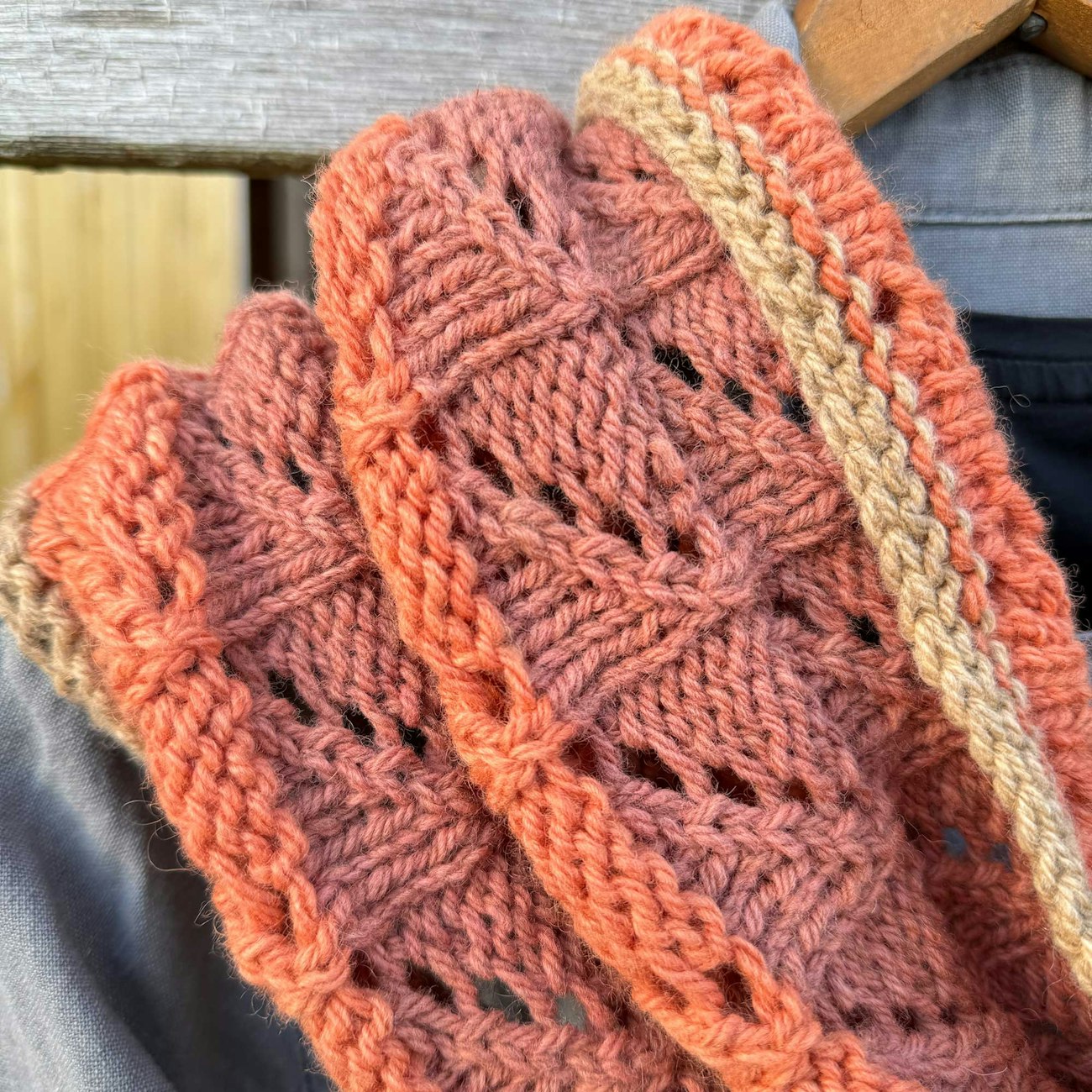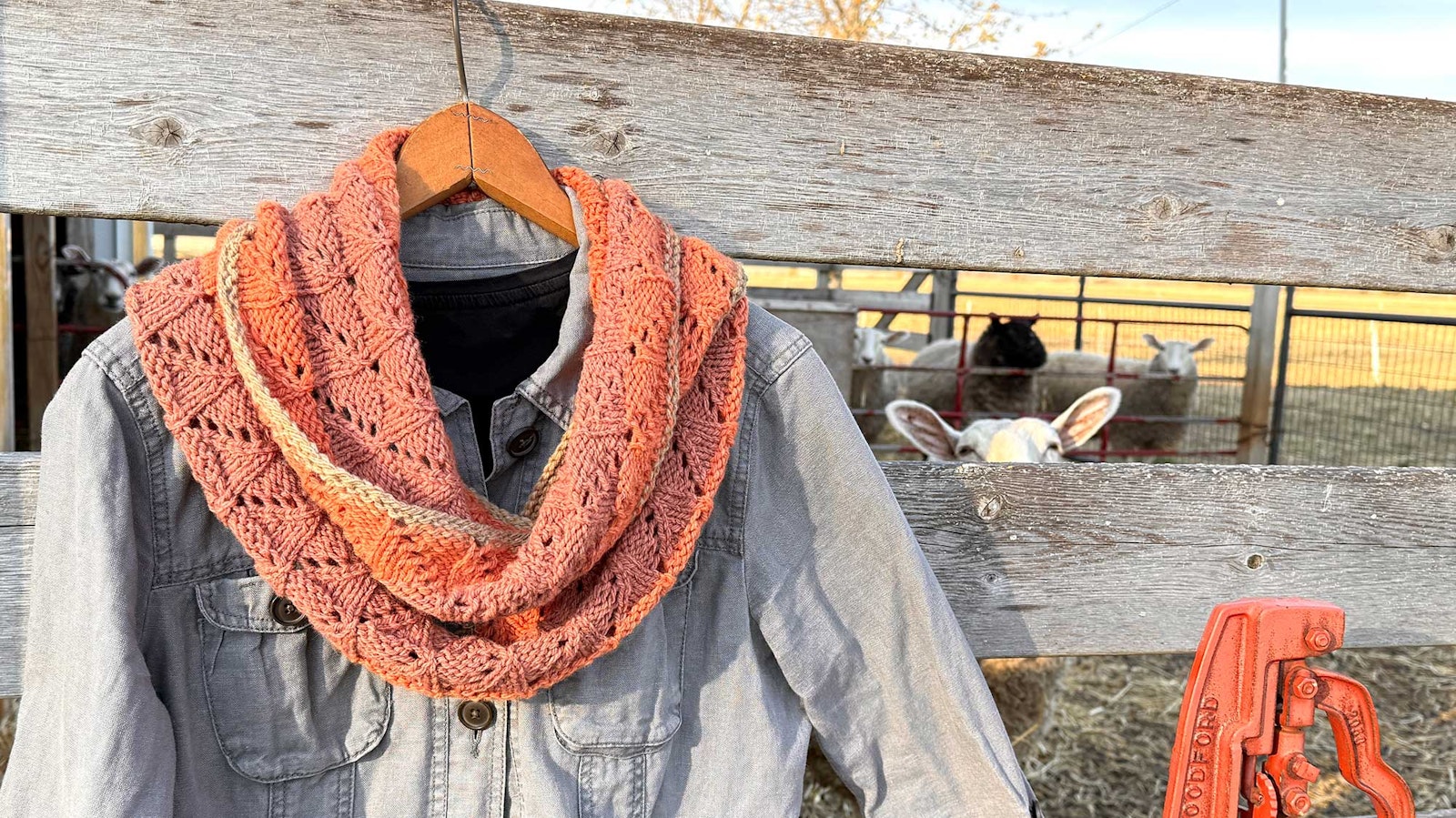Subscriber Exclusive
Knitting with Sheep (and a Cowl Pattern)
Yarn Chronicles episode 3 is out! Knit along with Kate and flocks near and far.
Yarn Chronicles episode 3 is out! Knit along with Kate and flocks near and far. <a href="https://farmfiberknits.com/knit-the-pleats-and-ladders-cowl/">Continue reading.</a>
https://farmfiberknits.com/cdn-cgi/image/format=auto/https://www.datocms-assets.com/101500/1730330875-larson-pleats-and-ladders-header.jpg?auto=format&w=900
As I shared a couple of weeks ago, learning more about Wing and a Prayer Farm through the four-episode video series, The Yarn Chronicles, sent me in search of the farm’s small-batch yarns. I started knitting as I traveled to New York Sheep and Wool, met shepherd Tammy White in person, and happily knitted my way through an amazing weekend in Rhinebeck.
The yarn I purchased from the farm store is a squishy, super plump worsted weight spun from the flock’s fine-wool Cormos. I wanted a long cowl that could be worn as a long loop or (more often) worn by wrapping twice. I love that this effect creates great stripes that mix when the cowl is doubled.

However, I feel strongly that such cowls either need to be knitted in a reversible stitch or something that is just as interesting on the wrong side as the right side. The Pleats and Ladders motif has become one of my favorites lately. It has interesting surface texture, doesn’t roll, is nearly reversible, and works great in either flat or circular knitting. (Subscribers will find the full pattern for this cowl below.)
 The right side of the fabric is shown on the left, wrong side is shown on the right. The main difference is that the decreases on the right side create a strong diagonal line under the yarn overs.
The right side of the fabric is shown on the left, wrong side is shown on the right. The main difference is that the decreases on the right side create a strong diagonal line under the yarn overs.
This was a very quick knit on US 7 (4.5 mm) needles, perfect for traveling and—in my case—spending some time with my flock after I got home. You might have noticed Lola photo bombed the image at the top of the page. Here is the rest of her sweet face.
 Lola was born this spring and is about seven months old now.
Lola was born this spring and is about seven months old now.
Episode 3 of The Yarn Chronicles is all about how this type of small-batch yarn can be passed from one step to the next within a community as it is transformed from raw fleece to finished yarn. Episode 4 “Knitting It All Together” is due out in mid-November. I hope you’ll knit along with Lola and me!
—Kate
Pleats and Ladders Cowl
The Pleats and Ladders stitch motif is wonderfully reversible and easily worked flat or in the round. This pattern can be easily adjusted for any yarn, any gauge, and any cowl size. Have fun and give it your own twist!
To change the gauge or finished circumference: When working in the round, simply knit a swatch in the stitch motif to find stitches per inch and estimate how many inches in circumference you would like your cowl to be. Multiply these two numbers and then adjust the cast-on number to be a multiple of 6 sts.
MATERIALS
SUBSCRIBER EXCLUSIVE
As I shared a couple of weeks ago, learning more about Wing and a Prayer Farm through the four-episode video series, The Yarn Chronicles, sent me in search of the farm’s small-batch yarns. I started knitting as I traveled to New York Sheep and Wool, met shepherd Tammy White in person, and happily knitted my way through an amazing weekend in Rhinebeck.
The yarn I purchased from the farm store is a squishy, super plump worsted weight spun from the flock’s fine-wool Cormos. I wanted a long cowl that could be worn as a long loop or (more often) worn by wrapping twice. I love that this effect creates great stripes that mix when the cowl is doubled.

However, I feel strongly that such cowls either need to be knitted in a reversible stitch or something that is just as interesting on the wrong side as the right side. The Pleats and Ladders motif has become one of my favorites lately. It has interesting surface texture, doesn’t roll, is nearly reversible, and works great in either flat or circular knitting. (Subscribers will find the full pattern for this cowl below.)
 The right side of the fabric is shown on the left, wrong side is shown on the right. The main difference is that the decreases on the right side create a strong diagonal line under the yarn overs.
The right side of the fabric is shown on the left, wrong side is shown on the right. The main difference is that the decreases on the right side create a strong diagonal line under the yarn overs.
This was a very quick knit on US 7 (4.5 mm) needles, perfect for traveling and—in my case—spending some time with my flock after I got home. You might have noticed Lola photo bombed the image at the top of the page. Here is the rest of her sweet face.
 Lola was born this spring and is about seven months old now.
Lola was born this spring and is about seven months old now.
Episode 3 of The Yarn Chronicles is all about how this type of small-batch yarn can be passed from one step to the next within a community as it is transformed from raw fleece to finished yarn. Episode 4 “Knitting It All Together” is due out in mid-November. I hope you’ll knit along with Lola and me!
—Kate
Pleats and Ladders Cowl
The Pleats and Ladders stitch motif is wonderfully reversible and easily worked flat or in the round. This pattern can be easily adjusted for any yarn, any gauge, and any cowl size. Have fun and give it your own twist!
To change the gauge or finished circumference: When working in the round, simply knit a swatch in the stitch motif to find stitches per inch and estimate how many inches in circumference you would like your cowl to be. Multiply these two numbers and then adjust the cast-on number to be a multiple of 6 sts.
MATERIALS[PAYWALL]
Yarn Wing and a Prayer Farm Peter Pan + Fam 3-Ply (100% Cormo wool; 126 yd [115 m]/2 oz; light worsted); Driftwood (Color A), Paprika (Color B), and Old Rose (Color C), one skein each.
Needles Size 7 (4.5 mm) 32" circular needle. Adjust needle size if necessary to obtain the correct gauge.
Notions Tapestry needle, marker.
Gauge 14 sts x 23 rnds = 4" (10.2 cm) in Pleats and Ladders patt.
Finished Size 6¾" tall x 62" circumference (17.1 x 157.5 cm).
Visit farmfiberknits.com/abbreviations for terms you don’t know.

INSTRUCTIONS
Using the long-tail method and Color A, cast on 216 sts; join in the rnd, being careful not to twist the cast-on row.
Rnd 1 Knit.
Rnd 2 Purl.
Break Color A.
Joing Color B and work Rnds 1–10 of Pleats and Ladders chart or written instructions below.
At the same time: Change colors as follows: after one chart repeat, break Color B. Join Color C and work chart twice. Break Color C. Join Color B and work chart once more. Break Color B.
Join Color A.
Rnd 1 Knit.
Rnd 2 Purl.
Rnd 3 Knit.
BO all sts very loosely purlwise.

Pleats and Ladders in the round (multiple of 6 sts):
Rnd 1 *K4, k2tog, yo; rep from * to end.
Rnd 2 *K5, p1; rep from * to end.
Rnd 3 *K3, k2tog, yo, p1; rep from * to end.
Rnd 4 *K4, p2; rep from * to end.
Rnd 5 *K2, k2tog, yo, p2; rep from * to end.
Rnd 6 *K3, p3; rep from * to end.
Rnd 7 *K1, k2tog, yo, p3; rep from * to end.
Rnd 8 *K2, p4; rep from * to end.
Rnd 9 *k2tog, yo, p4; rep from * to end.
Rnd 10 *K1, p5; rep from * to end.
Rep Rnds 1–10 for patt.

 The right side of the fabric is shown on the left, wrong side is shown on the right. The main difference is that the decreases on the right side create a strong diagonal line under the yarn overs.
The right side of the fabric is shown on the left, wrong side is shown on the right. The main difference is that the decreases on the right side create a strong diagonal line under the yarn overs. Lola was born this spring and is about seven months old now.
Lola was born this spring and is about seven months old now. 


